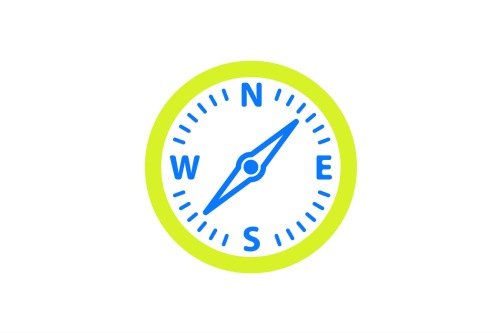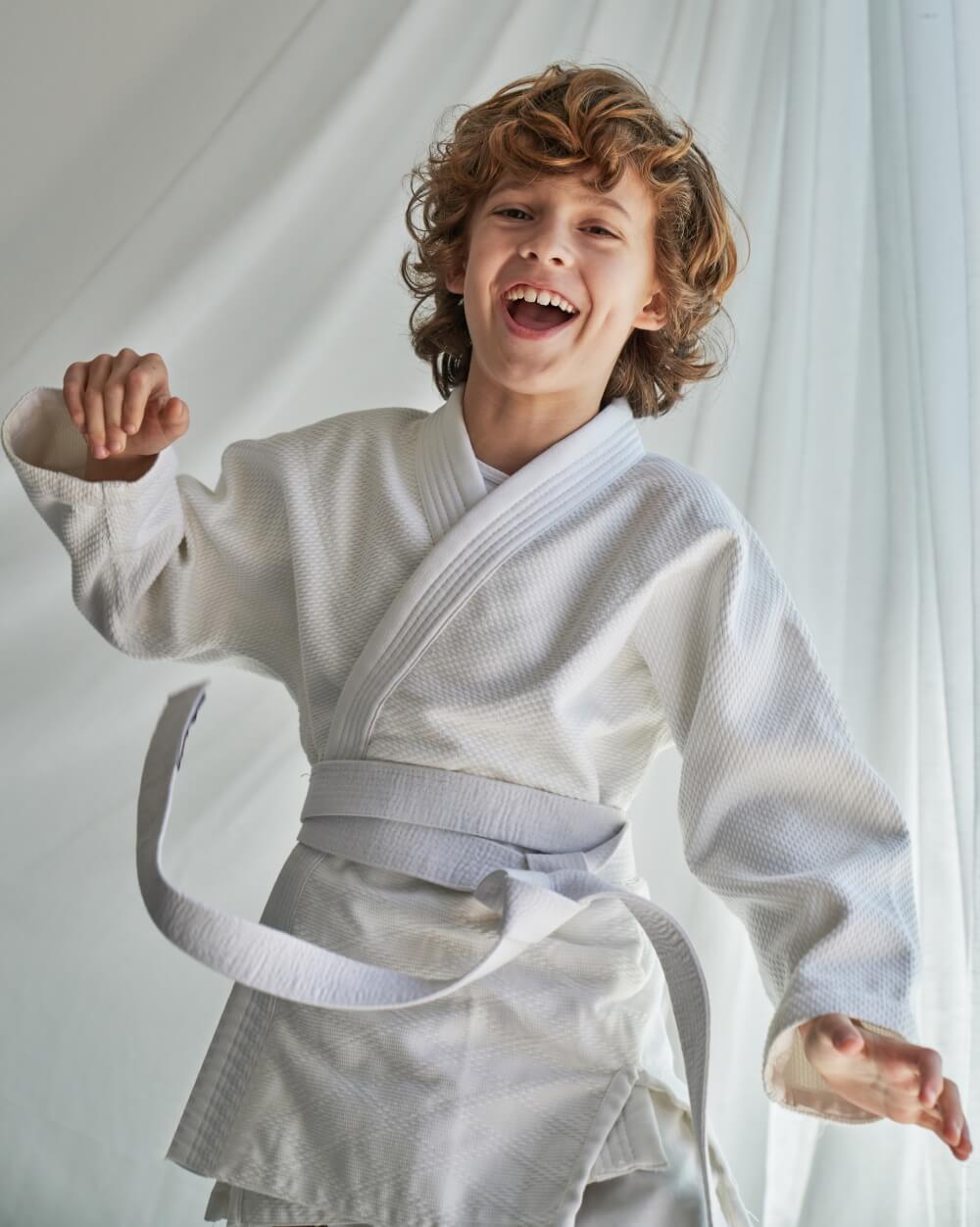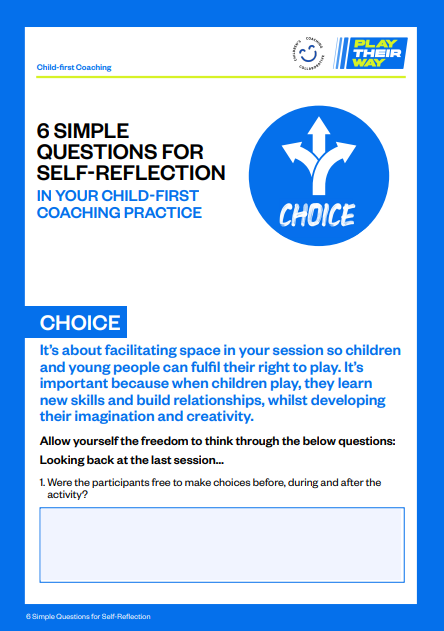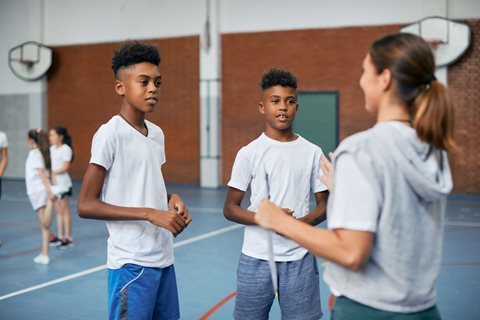Our cookies
We use essential cookies to make our website work smoothly for you. To make sure we're always improving, we'd like to use analytics to track how people use the site. We won't set non-essential cookies unless you give us permission. You can find more information about all the cookies we use in our Privacy and Cookie Policy.
Some cookies are a must for our website to function properly. If you turn off essential cookies, it may affect how you experience our site.
The non-essential cookies we use help us understand how you use our website and make improvements to enhance your experience.
Tips and Tricks for Coaches to Help Children Get a Kick out of Karate
We spoke to English Karate Federation Head Coach Ady Gray for some top tips on coaching karate to children and how to create child-first karate sessions. Ady is the founder of ‘The Karate Dojo’ based in Ripon, North Yorkshire, and a former winner of the UK Coaching Awards Children’s Coach of the Year

Included in this article:
- Using karate to teach life skills
- CHOICE: Key coaching insights and need-to-knows
- Important safety tips
- The effectiveness of language and storytelling
- Why coaches should embrace their inner child
- VOICE: Coaching a range of ages
- CHOICE: Unleash children’s imagination and creativity
- JOURNEY: Remember – Children are not machines
- Download FREE games resource
by Blake Richardson
Enjoyable and engaging sessions that improve children as people as well as performers is the real jewel in the crown of what karate has to offer kids – not belts or trophies.
According to Sensei Ady Gray 6th Dan, a yearning for earning prizes should not be the key motivational driver for participants, or the be-all and end-all for karate coaches.
Ady says he has seen too many clubs that prioritise coloured belt gradings over children’s holistic development, with personal progression playing second fiddle to progressing through the belt system – a series of stepping stones on the path to the goal of attaining the ‘holy grail’ of black belt.
Using karate to teach life skills
Training methods that are heavily weighted on perfecting karate techniques through dull rote practice tick Ady off, because they fail to tick off many of the far more important areas for development – skills for life that include:
- building self-confidence and self-esteem
- communication and leadership skills
- resilience and the ability to cope with pressure
- teamwork and collaboration
- problem-solving and decision-making.
These are the milestone achievements that Ady celebrates because they are the foundations on which lifelong memories are built.
“It’s not about just giving kids what they want in terms of gradings. Coaches are misleading children and doing them a disservice if the emphasis is on giving them belts to help them keep populating their clubs. And there’s a lot of that goes on.
I’m keen to teach children that it’s not just about kicking and punching, it’s about producing good people and happy people, who are equipped with the qualities needed to become well-rounded individuals.”
At the ‘Tigers’ class Ady delivers for his youngest students, aged four to six, there are no practical assessments.
“I’ve had many a conversation with parents, who say they’ve seen clubs where they hand out kicking badges, punching badges, turning up badges. That may be a way to motivate kids and give them an incentive to train. But the key objective for me is working with children who are motivated because they want to get better at something, not by non-stop rewards.”
The Coaching Compass
Start your child-first coaching journey with the Coaching Compass! Simply answer a few quick-fire questions to create your unique child-first coaching profile.
Chart Your Course
Key insights for coaching karate to kids
When structured lesson plans should give way to structured play
Do not be fooled into thinking that training sessions need to take the form of regimented lessons, where standard combinations and moves are worked on repetitively for the entirety of the class.
While the informal, mechanical style of karate teaching – where a coach keeps a watchful eye over their students as they practice techniques and sequences – is a necessary part of coaching karate to kids, you should leave plenty of room for game-based play, where the children are:
- empowered to take ownership of exercises
- encouraged to devise and adapt session plans and games
- given space to use their own imagination and creative expression, facilitated by the coach.
“This is especially important with the younger children,” says Ady.
“You need to assess how things are going in a class and be prepared to adapt lesson plans at a moment’s notice.
“For example, if we’ve done a lot of karate and the kids have learnt a lot in the session, it’s knowing when to leave it alone and just have some play time.
I know there is a stage where, if I try and make it even better, there is a danger I could make it worse again.”
As the saying goes, all work and no play makes Jack a dull boy. And as every coach knows, boredom in children will likely only motivate them to not return the following week.
Be loud and clear: Why it is important that children understand about personal safety
A karate instructor must create a safe environment to get the best out of every child in their class.
It is important, therefore, that children listen to the voice of their coach whose job it is to keep them safe. Equally, the coach must listen to the voice of the child, as this will help them feel safe, valued, and empowered – prerequisites for a healthy learning environment.

“When it comes to fun play, four to six-year-olds just want to run around. Fine, but to make them feel safe in my session, I must first get them to understand that when I raise my voice, I am not doing it to tell them off, I am doing it to motivate them.”
As Ady points out, it takes time to get to know children’s backgrounds. It could be a child who is new to your class is yelled at frequently by controlling parents and has anxiety and low self-esteem. Raising your voice would likely cause them further distress.
“You need to give them a reason, to gain their understanding from the very beginning.
So, I will incorporate that learning into a game. It can be a simple warm-up game where the children are running around and when I shout ‘yame’ (stop) I want them to freeze.
“After a while, to see if they have understood, I will say it really quietly, and the kids will encourage me to shout louder. So, the kids have some control over what the game looks like. I don’t want to dictate to them.”
For older children, Ady will explain the rationale behind the instruction to stop.
“I will tell them that it is important for their safety that they act immediately when I shout ‘yame’ because by stopping instantly it will keep them all safe.
“I will explain that if someone bangs their head in the dojo because they were not listening, that makes them upset, it makes me upset and their parents will not be very happy with me, or with them, if they found out they were not listening!”.

The effectiveness of language and storytelling
Ady says he uses examples from everyday life that children are familiar with to drive home the importance of listening to his instructions.
If a child bangs their head at school, normal protocol is to give the child a letter to hand to their parents, or to phone a parent.
Ady will say to his class: ‘Every day a child ends up having to take a letter home addressed to their parents because they weren’t looking where they were going at play time and bumped their heads.
‘I bet none of you have cracked your heads at school today, because you are real karate kids and have that sense of zanshin – which is the state of total awareness.’
Minutes later, when the children are running around, and Ady is familiarising them with the terms hajime (begin) and yame, not only will he have their full undivided attention, but the children will also be eagerly honing their zanshin as they make a concerted effort not to bump into anyone or anything.
Embrace your inner child: Feed off children’s energy and let them feed off yours
In a safe and managed learning environment that is fun and inclusive, children can relax and truly be themselves.
To ensure everyone in his class is made to feel that they belong and are valued, Ady will embrace his inner child and demonstrate as much enthusiasm and amusement for a task as his children.
“We’ll even do some maths! Silly stuff but you can make anything game-like if you put your mind to it,” he says.
“The idea is I want to start hearing their voice a bit and drum up some enthusiasm among the whole class.
“However many kids are in the class, that is the answer to every question. So, a child who perhaps isn’t that academic, or good at maths, won’t feel inferior by not being able to get the answer and will be able to take part.”
Here’s how it could unfold:

Ady: What’s 9 add 1?
Class: 10!
Ady: What’s 8 plus 2?
Class: 10!
Ady: Okay, what’s ten billion, times by a hundred, divided by 70 and take away three thousand…
Puzzled faces and sideways glances
Ady: And now finally divide that number by three monkeys and a cow.
Cue hysterical laughter, followed by…
Class: 10?
Ady: Wow, you are all child geniuses!
I know then they are ready for karate. They feel really special, feel relaxed and feel equal because they have all been laughing and actively involved.”
Coaching a range of ages
Ady provides some simple ideas for how to connect with children at different ages when coaching karate.
For younger children aged 4 to 6, he will empower them in the decision-making process.
“I will ask them ‘what things do you do at school?’, ‘what are your favourite games you play at break time?’
“Then I think, how can I adapt and mould that, so the learning game focus is on developing a karate technique or a fundamental movement skill while retaining the fun element?”
Take a simple variation on the traditional game of Tig.
When one player touches another, the person who is ‘tigged’ – and is now ‘it’ – has to perform a sequence of karate moves, or an exercise like star jumps, burpees, squat thrusts or press-ups, before running off to pursue someone else to tig.
Instead of using the whole dojo, you can limit the playing space. The smaller the area, the faster the footwork has to be to evade being tigged, and the more dexterous the chaser has to be to reach out and touch people as they dodge, jink and weave.
It is important when coaching karate to kids to be open-minded and receptive to new ideas and information.
“You might see a really good idea on social media. I see a lot of things when I take my son boxing that I can mould to karate,” says Ady.
“So, if you see them using resistance bands in a football training session, ask yourself why they are using them. Don’t copy it. Create your own version of it.
“I’ve even done it with yoga, because there are so many cross-over benefits to karate, such as strength control and injury prevention.”
Ady admits that it can cause a few raised eyebrows, especially from the older children he coaches. But when they see the benefits, he soon makes a believer out of them.
The trick is to always have an analogy to hand, as that helps children digest new ideas quickly by making them more easily understood.
“I don’t use mats in my dojo, we use a sprung floor that absorbs shocks. A lot of the older kids who take part in competitions have grown up using mats and will say ‘oh, I can’t do it on a hard floor’.
“I will reply, ‘would a dancer complain they are on a hard floor? They are twisting, turning, jumping, landing. All the same basic skills as you are doing, but they wouldn’t do it on a mat. So there must be a reason why’.”
Learn more about coaching kids with mixed abilities in a child-centric way.
Game Ideas
Download game ideas that will support the children and young people in your session to play their way.
FREE RESOURCE
Unleash children’s imagination and creativity
Coaches need to cultivate the power of a child’s imagination “to see them excel in sessions”.
Take the triple stepping punch.
Ady’s advice: “Get to know what the kids are into. Who is the big baddie out there at the moment?”
Have that conversation, and if they say Voldemort from Harry Potter, or Thanos from the Avengers films, then tell them to picture them in their minds. That is who is in front of them, and they are the superhero.
If some people aren’t doing the movements correctly, or some are lacking confidence, you can harness the same comic book hero theme as a technique to develop their understanding of teamwork.
You could explain that to stop the alien invasion, each member of the group has an important role to play, and everyone needs to work together as a team, just like they do in the Avengers movies.

“I’m always looking for new ways to teach something or improve someone,” says Ady, who is a strong believer in using evocative imagery when coaching karate to kids to provoke an immediate, impassioned emotional response.
Making the effort to understand young people and form connections by taking an interest in their world is integral to building children’s trust, rapport and sense of belonging. It will make you more relatable, and the child or young person will appreciate being listened to.
Children are not machines. Celebrate their differences and develop their personalities

Kids’ motivations for coming to karate will vary greatly. Each will be striving for different goals and outcomes, be at different stages of development, and be at different ages.
How does a karate coach flex and adapt their child-first approach to suit the differing needs of their participants?
“I treat everyone I coach as an individual, rather than comparing them to someone else of the same age or who started the sport at the same time,” says Ady.
“Ninety per cent of my students aren’t interested in competition. They want to do karate for everything else they can get out of the sport.
“Competitions are black and white, there is no room for error. You have to be better than that other person. For me, their personal development is more important, becoming a better person.”
Ady says he does not coach children to look like robots – copy, repeat, copy, repeat.
The approach of repetition to perfection overlooks the fundamental importance of personality.
Karate is structured but I don’t want to create robots who do everything at exactly the same time, the same speed – like an army who are immaculate clones of each other.
“If my kids don’t make any mistakes, then I don’t have a job.
Ady Gray The Karate Dojo
“There isn’t such a thing as the perfect technique because every person is different. If a block works in karate, it may not be classically correct, but if it works then it’s the perfect end result.
“It’s more important to me for kids to have a personality and I tell my students to be who they are. It’s important to have those quirks that make you an individual.”
Other resources you may like...
SHARE THE MOVEMENT
Help spread the word by sharing this website with fellow coaches!



